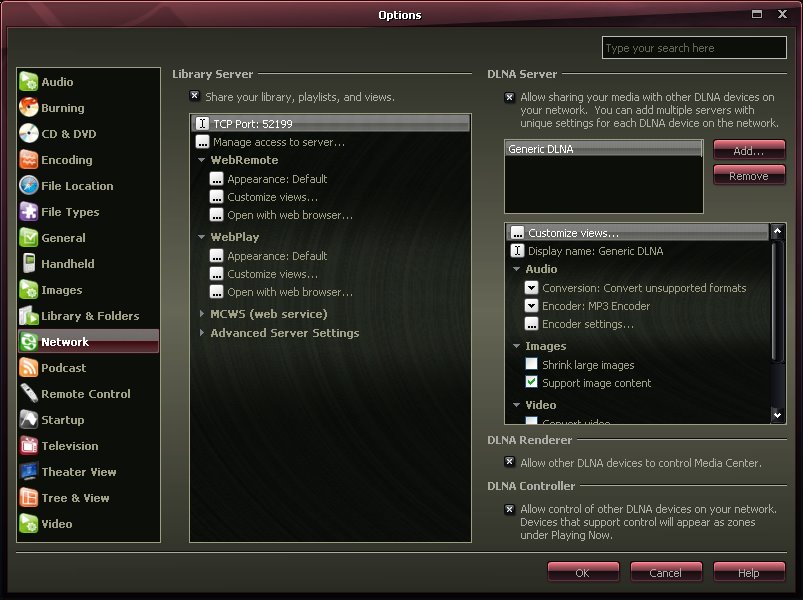Servers: Difference between revisions
| Line 5: | Line 5: | ||
[http://wiki.jrmediacenter.com/index.php/DLNA DLNA Server] is similar to Library Server but uses an industry standard protocol. It can be used with both software and hardware from many sources. Terminology for this server was changed to DLNA / UPnP Server in MC14, and to DLNA Server in MC15. DLNA and UPnP are similar but not identical protocols. For old versions of MC, see also [http://wiki.jrmediacenter.com/index.php/UPnP_Server_and_Devices_%28Media_Receivers%29 UPnP Server]. |
[http://wiki.jrmediacenter.com/index.php/DLNA DLNA Server] is similar to Library Server but uses an industry standard protocol. It can be used with both software and hardware from many sources. Terminology for this server was changed to DLNA / UPnP Server in MC14, and to DLNA Server in MC15. DLNA and UPnP are similar but not identical protocols. For old versions of MC, see also [http://wiki.jrmediacenter.com/index.php/UPnP_Server_and_Devices_%28Media_Receivers%29 UPnP Server]. |
||
If you're connecting two Media Center PCs, Library Server is the preferred method. Library Server allows bi-directional syncing, zone linking, playlist and view support, television recording, and several other things beyond the scope of DLNA. |
|||
[http://wiki.jrmediacenter.com/index.php/WebRemote WebRemote] is a more graphical version of the old Remote Server. |
[http://wiki.jrmediacenter.com/index.php/WebRemote WebRemote] is a more graphical version of the old Remote Server. |
||
Revision as of 18:36, 27 October 2010
Overview
J. River Media Center includes several servers.
Library Server, formerly called Media Server, can serve a media collection on one PC, so it can be played with another copy of MC on another PC anywhere on the Internet.
DLNA Server is similar to Library Server but uses an industry standard protocol. It can be used with both software and hardware from many sources. Terminology for this server was changed to DLNA / UPnP Server in MC14, and to DLNA Server in MC15. DLNA and UPnP are similar but not identical protocols. For old versions of MC, see also UPnP Server.
If you're connecting two Media Center PCs, Library Server is the preferred method. Library Server allows bi-directional syncing, zone linking, playlist and view support, television recording, and several other things beyond the scope of DLNA.
WebRemote is a more graphical version of the old Remote Server.
Tivo Server can serve MC's library to a TiVo.
MC14 introduced a Web Service Interface which can be used by developers.
Several third party applications can use MC interfaces to control the player. See Remotes for more information.
Configuration
Configuration is under Options/Media Network in MC15. In earlier versions, it was in the relevant location under Servers and Plug-ins in the tree.
Formerly, configuration was located in MC's tree, under Services and Plug-ins.
Logging
Under Services and Plug-ins in the tree, you will find Network Servers (formerly DLNA or UPnP Server), where logging can be seen for both DLNA and Library Server.
Media Server
Media Server is a small program that runs in the background. It can be set to start with Windows Startup under Tools/Options/Startup/Windows Startup. Media Server can start other servers when they are needed. It appears in the lower right corner of the desktop, and it will show up in the task manager as Media Center. It was introduced in MC12.
Decommissioned
Several older servers have been retired and replaced.
Remote Server was replaced with the more graphical WebRemote in MC15. Remote Server was a small web server built into MC, and allows MC to be controlled from a web browser running on another PC.
UPnP Server was folded into the DLNA Server in MC15.
The component known as Media Server in MC11 and earlier versions is now Library Server.
